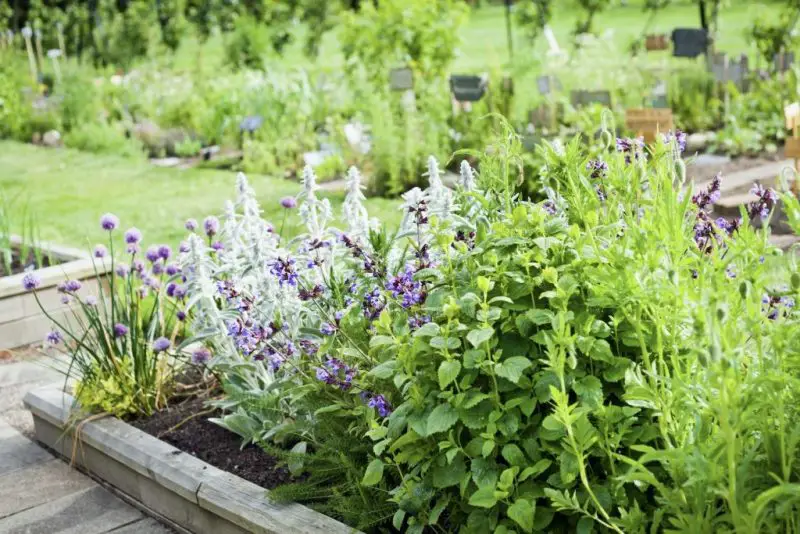Rosemary is a wonderfully aromatic herb, cherished for its woody fragrance and culinary versatility. When planted in a raised bed, rosemary not only thrives due to the improved soil drainage and warmth but also serves as a stunning focal point for any herb garden. However, the question many gardeners face is what to plant alongside rosemary to create a thriving, harmonious herb garden that benefits both the plants and the gardener’s kitchen.
Selecting companion plants for rosemary in a raised bed involves understanding rosemary’s growth preferences, its natural habits, and how it interacts with other plants. This knowledge helps in creating an herb garden that is productive, visually appealing, and resilient. Let’s explore the best plants to pair with rosemary and the principles behind companion planting in raised beds.
Table of Contents
Understanding Rosemary’s Growing Conditions

Rosemary is a Mediterranean herb that flourishes in warm, sunny, and well-drained environments. Raised beds offer an ideal growing space as they improve soil drainage and can warm up faster in spring, giving rosemary a head start.
Rosemary prefers slightly alkaline to neutral soil with good drainage. Heavy, waterlogged soil can cause root rot, making drainage a critical factor. It thrives in full sun, needing at least six to eight hours of direct sunlight daily. Rosemary is drought tolerant once established but does not do well in overly wet or humid conditions.
Knowing these requirements helps in choosing companion plants that share similar soil and moisture preferences, ensuring all herbs in the raised bed thrive together.
Benefits of Companion Planting with Rosemary in Raised Beds
Companion planting involves grouping plants that mutually benefit each other. With rosemary, companion plants can improve pest control, enhance growth, improve flavor, or attract beneficial insects. In raised beds, where space is limited, companion planting maximizes the use of available soil and sunlight, improving garden productivity.
Rosemary’s strong scent deters certain pests, making it a natural protector for more vulnerable herbs. Its woody structure also provides a visual and physical anchor in the raised bed design.
Additionally, planting compatible herbs together simplifies care routines, as they usually have similar watering and sunlight needs.
Ideal Herbs to Plant with Rosemary
Many herbs complement rosemary not only in the kitchen but also in the garden. Herbs like thyme, sage, and oregano share rosemary’s love for sunny, well-drained conditions, making them ideal raised bed companions.
Thyme is a low-growing herb that thrives alongside rosemary without competing for space. Its dense mat-like growth helps suppress weeds and retains soil moisture around rosemary’s roots.
Sage, with its woody stems and textured leaves, harmonizes well with rosemary visually and culturally. Both herbs have similar water needs and grow well in the same soil types, making maintenance easier.
Oregano is another Mediterranean herb that shares rosemary’s drought tolerance and sun requirements. Its spreading habit fills gaps in the raised bed, providing ground cover that reduces soil erosion.
These herbs together create a Mediterranean-themed herb garden rich in flavor and aroma, perfect for culinary uses.
Vegetables That Pair Well with Rosemary in Raised Beds
Certain vegetables benefit from being planted near rosemary. Root vegetables like carrots and beans are good companions as rosemary’s aroma can repel carrot flies and bean beetles, protecting these crops naturally.
Carrots thrive in loose, well-drained soil, which raised beds provide, and their growing habit does not compete with rosemary’s woody roots. Beans, especially pole beans, can grow vertically around rosemary without overcrowding the herb.
Rosemary’s drought tolerance complements vegetables that prefer slightly drier soil, making the combination sustainable and efficient. However, it is important to avoid planting vegetables that require consistently moist soil too close to rosemary to prevent root competition and moisture-related diseases.
Flowers That Enhance Rosemary’s Growth and Appeal
Incorporating flowers in a raised bed with rosemary adds visual interest and attracts pollinators and beneficial insects. Flowers like lavender and marigold thrive in similar conditions as rosemary and provide ecological benefits.
Lavender’s silvery foliage and fragrant purple blooms pair beautifully with rosemary’s green needles and blue flowers. Both attract pollinators such as bees and butterflies, which improve herb and vegetable yields.
Marigolds are known for their pest-repelling properties, especially against nematodes and aphids. Their bright blooms add color contrast, enhancing the garden’s aesthetic.
These flowers help create a biodiverse raised bed that supports a healthy garden ecosystem.
Tips for Designing a Raised Bed with Rosemary and Companions
When designing a raised bed, consider plant heights, growth habits, and space requirements to ensure each plant has adequate room and light. Rosemary’s upright, bushy form makes it a good central or back-of-bed feature, with lower-growing herbs and flowers planted around its base.
Companion plants should not overshadow rosemary or compete aggressively for nutrients. Group plants with similar water needs to avoid overwatering rosemary or underwatering its neighbors.
Incorporate organic mulch to retain moisture and regulate soil temperature, benefiting all plants. Regular pruning of rosemary encourages airflow and reduces the risk of fungal diseases in crowded beds.
Rotating crops and companions seasonally prevents soil depletion and pest buildup, keeping the raised bed productive over time.
Caring for a Rosemary Companion Herb Garden in Raised Beds
Maintaining a raised bed herb garden with rosemary and companions requires regular monitoring. Check soil moisture frequently, ensuring it remains evenly moist but well-drained. Avoid letting soil dry out completely or stay soggy.
Fertilize sparingly with balanced organic fertilizers, as excessive nutrients can reduce the concentration of essential oils in herbs like rosemary and thyme.
Watch for pests and diseases, using organic treatments when needed. Companion planting naturally reduces many pest problems, but vigilance helps keep the garden healthy.
Prune rosemary and other herbs regularly to promote bushier growth and prevent overcrowding. Harvest herbs frequently to encourage continuous production.
Seasonal Considerations for Rosemary and Companion Plants
In colder climates, raised beds warm faster but may require protection for rosemary during winter. Using mulch or moving pots indoors protects sensitive herbs from frost.
Spring is the best time to plant rosemary and companions, allowing them to establish before summer heat. Summer requires attentive watering and shade during extreme heat to prevent stress.
Fall offers an opportunity to plant hardy companions or prepare the bed for winter by adding organic matter.
Planning companion planting with seasonal changes in mind ensures year-round productivity and a healthy herb garden.
Common Challenges and Solutions When Growing Rosemary with Companions
One challenge is managing differing water needs; rosemary prefers drier conditions, while some herbs or vegetables might need more moisture. Careful plant selection and watering techniques help resolve this.
Another challenge is space limitation; overcrowding can reduce airflow and increase disease risk. Pruning and strategic planting layout mitigate these issues.
Pests may still occasionally attack, but companion planting often reduces infestations. Regular inspection and prompt action keep problems manageable.
Understanding the unique needs of each companion plant while maintaining rosemary’s health is key to overcoming common gardening challenges.
FAQs About Planting with Rosemary in Raised Bed
What herbs grow best with rosemary in a raised bed?
Herbs like thyme, sage, and oregano thrive alongside rosemary because they share similar sun and soil preferences.
Can vegetables be planted with rosemary in raised beds?
Yes, root vegetables like carrots and beans benefit from rosemary’s pest-repellent properties and grow well in raised beds.
Which flowers complement rosemary in a raised bed?
Lavender and marigolds are great companion flowers that attract pollinators and repel pests near rosemary.
How should I arrange companion plants around rosemary?
Place taller rosemary plants centrally or at the back, with lower-growing herbs and flowers around the base for best sunlight and airflow.
How often should I prune rosemary and its companions in raised beds?
Regular pruning encourages bushy growth, improves airflow, and prevents overcrowding; prune herbs whenever you harvest to promote new growth.
Conclusion
Creating a thriving herb garden with rosemary in a raised bed depends largely on choosing the right companion plants and understanding their shared needs. Herbs like thyme, sage, and oregano, along with select vegetables and flowers, complement rosemary’s growth habits and cultural preferences, resulting in a harmonious and productive garden.
Proper design, care, and seasonal adjustments ensure that rosemary and its companions flourish, providing a bounty of flavorful herbs and attractive blooms. Companion planting with rosemary in raised beds maximizes space, enhances pest control, and adds beauty to the garden, making it a rewarding endeavor for gardeners of all levels.






